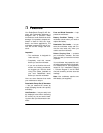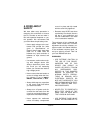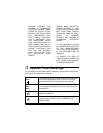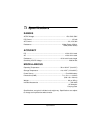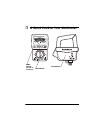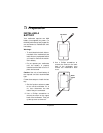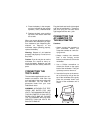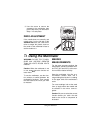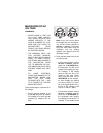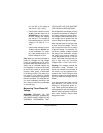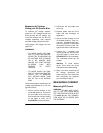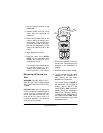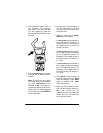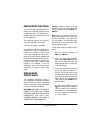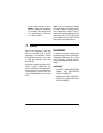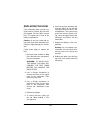
11
Using the Multimeter
MEASURING DC/AC
VOLTAGE
WARNINGS:
• NEVER CLAMP A TEST LEAD
TO A HOT WIRE (USUALLY
RED, BLACK, OR BLUE IN AC
WIRING CIRCUITS). IF ONE
LEAD IS CLAMPED TO A HOT
WIRE AND YOU TOUCH THE
MULTIMETER’S OTHER
PROBE, YOU COULD RECEIVE
AN ELECTRIC SHOCK.
• THE MAXIMUM INPUT LIMIT
FOR VOLTAGE MEASURE-
MENT IS 500V DC OR 500V AC
(RMS). TO AVOID ELECTRI-
CAL SHOCK AND DAMAGE TO
THE MULTIMETER, NEVER
TRY TO MEASURE DC VOLT-
AGE ABOVE 500 VOLTS OR AC
VOLTAGE ABOVE 500 VOLTS
RMS.
• TO AVOID ELECTRICAL
SHOCK AND DAMAGE TO THE
MULTIMETER, NEVER CON-
NECT THE TEST PROBE
PLUGGED INTO THE
–
JACK
TO A SOURCE OF VOLTAGE
ABOVE 500 VOLTS.
Follow these steps to measure AC or
DC voltage.
1. Set the function selector to one
of the
DCV
positions (to measure
DC voltage) or to one of the
ACV
positions (to measure AC volt-
age).
Note:
If you are not sure about
the voltage level you are measur-
ing, set the function selector to
500 DCV
or
500 ACV
. Then keep
trying the next lowest range as
necessary until the reading
appears in the upper third of the
multimeter’s scale.
2. Touch the test leads to the circuit
you want to test.
• If the function selector is set to
500 ACV
or
500 DCV
, read the
upper line of
ACVA/DCVA
on
the multimeter. The AC or DC
voltage is the reading you see.
For example, if the needle
points to 200, the AC or DC
voltage is 200 volts. Other-
wise, read the lower line of
ACVA/DCVA
on the multime-
ter then multiply the reading
you see by 500/3. For exam-
ple, if the needle points to 2.4,
the AC or DC voltage is 400
volts (2.4
×
500/3 = 400V).
• If the function selector is set to
150 ACV
or
150 DCV
, read the
lower line of
ACVA/DCVA
on
the multimeter then multiply
the reading you see by 50. For
example, if the needle points



